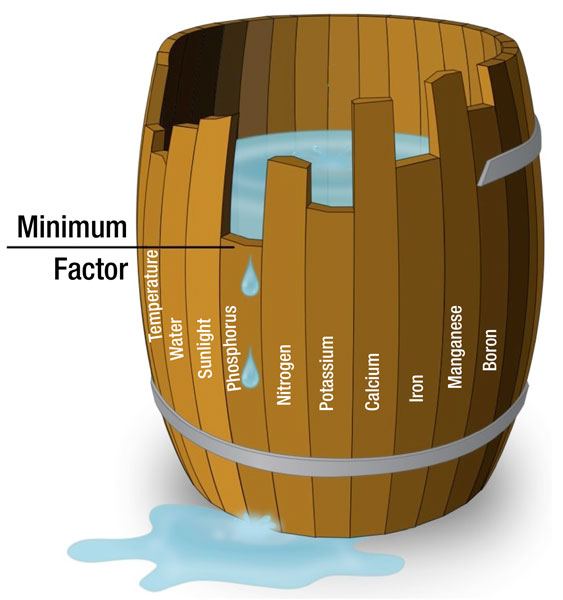10/1/2021
Growth Factors: The Law of the Minimum
Albert Grimm

Justus von Liebig published the “Law of the Minimum” almost 200 years ago. The title may suggest a treatise on work avoidance, but the concept is really one of the fundamentals of agricultural science. It permeates farming everywhere and farmers use it daily, often without realizing it.
The idea is very simple: According to the Law of the Minimum, the rate of plant growth is not determined by the most abundant growth factor, nor by the sum of all available factors, but it’s limited by the single scarcest of these growth factors. In other words, a plant can only grow as fast as the most deficient growth factor allows, no matter how abundant the other factors might be. This concept is often visualized by Liebig’s barrel illustration (see the image). Growth factors include not just the mineral macronutrients (N, P, K, Ca, Mg, S) and micronutrients (Fe, Mn, Cu, B, Zn, Mo, Cl), but equally important temperature, light, water, CO2 and oxygen.
Scarcity, not abundance, determines how plants grow and develop. This is significant in nature and for farming. Plants outcompete other plants when they become very effective at making the best use of the scarcest growth factor in their native habitat. The better a species adapts to local scarcity, the more successful it competes in the habitat. Species with the lowest minimum requirement for the scarcest resource take over. This allows us to understand the behavior of our crops and gain better control over their development. We gain crop control with targeted limitations, not by providing abundance.
Certain growth factors are outside of our control. For example, daily light sum in fall and winter often limits growth in high-light crops. We cannot compensate for this scarcity by increasing other factors, such as temperature or nitrogen. The opposite is required. If we want to avoid weak plants and poor quality, we need to reduce all abundance until it’s in balance with light as the minimum growth factor. Growers in northern latitudes can do this by increasing crop time, turning down the heat, and reducing input of fertilizer and water.
Usually, it’s not even in our interest to optimize every single growth factor. Balanced abundance maximizes biomass production, but for greenhouse growers this is rarely an objective. Tomato and pepper growers want to harvest fruit, not biomass.
Bedding plant growers look for large, early flowers over compact canopies—quite the opposite of maximized biomass accumulation. We can enhance these desired crop traits by reducing general abundance and by limiting specific growth factors until we’ve created selective scarcity. In ornamentals, we accomplish this by modestly reducing nitrogen, phosphorus and temperature.
Prerequisite is always to understand how each crop has adapted to its natural habitat. For example, certain species, such as African violets, have very successfully adapted to forest floors where light is very scarce. This makes them ideal houseplants. They’re less well equipped to handle limitations of heat or water because it’s never cold or dry where they come from. Scarcity of water or heat disproportionately limits these crops. We can use this for control, but we must be careful because they aren’t equipped to handle serious cold or severe drought.
Conversely, plants like pelargonium will suffer in the heat of our dark windowsills because they’ve evolved in an abundance of light. Light is the limiting factor for pelargonium in our greenhouses, but they’ve learned how to survive long drought and cold nights. So we can reduce water and temperature to balance lack of light and create effective limitations for growth even when light is abundant. Just don’t try to grow pelargonium under heavy shade. GT
Albert Grimm is head grower for Jeffery’s Greenhouses in St. Catharines, Ontario, Canada.